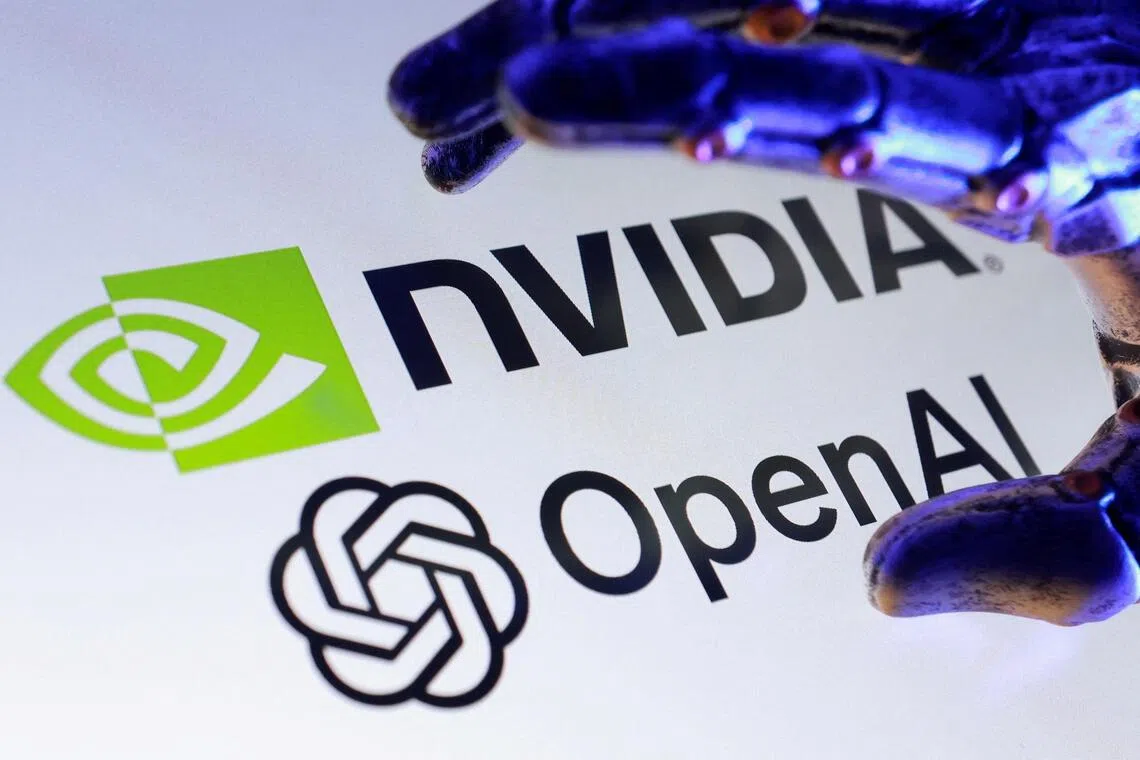AI bubble fears rise with stocks seeing US$100 billion swings
Sign up now: Get ST's newsletters delivered to your inbox

AI boom's reliance on a web of circular deals, notably the one involving OpenAI and Nvidia, is also raising fears of a bubble..
PHOTO: REUTERS
Follow topic:
NEW YORK – Investors are excited about OpenAI’s expansion driving big gains in technology stocks, but a rising number of Wall Street pros fear that the wild pops that add tens of billions of dollars in value in mere minutes are signalling an unhealthy market reminiscent of the dot.com era.
Advanced Micro Devices (AMD) took this rocket ride on Oct 6, as the company’s stock soared, briefly boosting its market capitalisation by roughly US$100 billion (S$129 billion) at an intraday high, after the chipmaker signed a deal with OpenAI that could lead to billions of dollars in revenue.
AMD’s shares extended gains into a second day, rising as much as 7.5 per cent on Oct 7.
This follows a 36 per cent jump in Oracle shares in September, which added US$255 billion to the software firm’s market value in a single session, after it gave blockbuster guidance for its cloud business, including an agreement with the ChatGPT operator worth US$300 billion over five years.
“If any one of these deals falls through it has this domino effect downstream that I think is concerning,” said Zacks Investment Management client portfolio manager Brian Mulberry. “It reminds me of what happened with telecoms back in the mid-90s.”
The moves come amid growing concern about a bubble forming around artificial intelligence as the key players – namely Nvidia and OpenAI – pledge billions of dollars in deals with a cohort of companies making infrastructure for the technology.
As more money is spent, there is mounting fear that the trend will end in a crash the way it did 25 years ago following the dot.com euphoria, when heavy investments were made in anticipation of internet traffic that took much longer to materialise.
An unwinding could be even more painful today, as the top tech stocks account for roughly 35 per cent of the S&P 500 Index, compared with less than 15 per cent in 1999.
“The market is pricing these deals as if everyone who transacts with OpenAI will be a winner,” said Jonestrading chief market strategist Michael O’Rourke. “OpenAI is a negative cash flow company and has nothing to lose by signing these deals. Investors should be more discerning. But this is a buy-first, ask-questions-later environment.”
Hedge fund billionaire Paul Tudor Jones, in an interview with CNBC’s Squawk Box on Oct 6, said the current backdrop reminds him of the dot.com bubble.
“All the ingredients are in place for some kind of a blow-off,” he said. “Will it happen again? History rhymes a lot, so I would think some version of it is going to happen again.”
Mr Jones added that this environment is “more potentially explosive than 1999”.
AI’s web of circular deals
One of the big concerns about the deals is their circular capital structures, with the companies using each other’s money to buy each other’s products, analysts said.
One notable example: Nvidia announced a US$100 billion deal with OpenAI, which will likely buy chips from Nvidia, which will reinvest those profits in OpenAI, which will likely use those funds to buy even more Nvidia chips.
Another example: Nvidia is investing in OpenAI, which is buying cloud computing from Oracle, which is buying chips from Nvidia, which has a big stake in CoreWeave, which is providing AI infrastructure to OpenAI.
In addition, the scale of the stock market moves for such large companies is alarming, said Zacks Investment Management’s Mr Mulberry.
These are companies with “very large mature balance sheets that are participating in these types of rallies”, he said.
“That is unusual, and it does cause a little bit of reflection,” Mr Mulberry added.
To be sure, AMD’s climb may be justified because the OpenAI deal signifies a major step in its progress with graphics processing units, or GPUs, where it competes for market share with Nvidia.
Wall Street analysts covering AMD generally cheered the news.
Still, having multiple large technology stocks surge by double digits in quick succession could be a sign that valuations have become disconnected from underlying fundamentals, and that investors are buying primarily based on the fear of missing out on further gains.
“The price discovery is actually pretty scary,” Mr Ted Mortonson, a technology strategist at Robert W. Baird & Co, said after Oracle’s pop.
A company that large, gaining so much market value that rapidly, is “not good and normal”, he added.
“I would call it a part of the exuberance bundle.” BLOOMBERG

